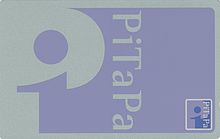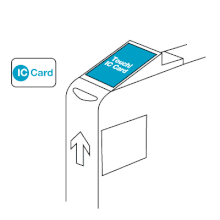PiTaPa
This article needs to be updated. (June 2019) |

PiTaPa (Japanese pronunciation: ピタパ) is a contactless smart card ticketing and electronic money system used predominantly the Kansai region of Japan. The name PiTaPa is an acronym of "Postpay IC for Touch and Pay".[1] In the Osaka area, PiTaPa is usable on the Osaka Municipal Subway and New Tram, Keihan Electric Railway, and Hankyu Railway. It launched on August 1, 2004.
Part of the Nationwide Mutual Usage Service, PiTaPa is usable on public transport across Japan.[2] Unlike Japan's other major IC cards, PiTaPa operates as a post-pay system, rather than as a prepaid card.

System overview[edit]
PiTaPa is operated by Surutto KANSAI, a private company composed of various transit companies and transportation bureaus.
Unlike most other electronic fare collection systems and IC cards in Japan, including JR East's Suica and JR West's ICOCA which operate on a "pre-pay" basis, PiTaPa is a "post-pay" card. Usage of the card is charged to the customer's account, and each month the balance owing is deducted from a designated bank account, as in a charge card. As such, a credit check is required to obtain a PiTaPa card, and the allowable balance is capped. This prevents short-time overseas visitors or short-term residents of Japan from obtaining or using PiTaPa.
Beginning in June 2006, people over 20 could obtain a PiTaPa secured by a deposit in lieu of the credit check, although these cards could only be used to pay transport fares or in limited stores, without the electronic money functions of a normal credit card. This service was discontinued in March 2022.[3]
The underlying technology behind PiTaPa is an RFID technology developed by Sony called FeliCa.[4]
Card types[edit]
"PiTaPa Basic Card" is the name given to the PiTaPa cards per se, and are issued by the Surutto KANSAI Conference.
Most traffic companies in the PiTaPa network issue PiTaPa-compatible cards of their brands, either on their own or jointly with other companies. The cards, called "PiTaPa Affiliate Cards" by the Surutto KANSAI Conference, typically are built within credit cards and have special services or discounts offered by its issuers.
In 2006, because of heavy marketing of the Affiliate Cards by the individual companies, Basic Cards constituted only 10–20 percent of all issued PiTaPa cards.
History[edit]
The concept to introduce a smart card fare system in the Kansai region was first announced on July 7, 2001, by the Surutto KANSAI Conference. The Conference initially announced in April 2002 that they were planning to consign operation of the system to Hitachi Ltd. and JCB, but switched to the Japan Research Institute and Sumitomo Mitsui Card Company in July 2003. The name "PiTaPa" was made public on February 25, 2003.
After four months of initial monitor testing, the service officially started on August 1, 2004, with three participating companies: Hankyu, Keihan, and Nose Railway.
Companies and bureaus accepting PiTaPa[edit]

In 2013, PiTaPa became usable in all major cities across Japan as part of the Nationwide Mutual Usage Service.[5] Prior to this, PiTaPa had been implemented and released as part of Affiliate Cards by a variety of companies and operators:
Rail[edit]
| Company name | Name of affiliate card | Joined |
|---|---|---|
| Hankyu Railway | HANA PLUS Card † | August 1, 2004 |
| STACIA Card | October 1, 2007 | |
| Nose Electric Railway | HANA PLUS Card † | August 1, 2004 |
| STACIA Card | October 1, 2007 | |
| Keihan Electric Railway | e-kenet PiTaPa | August 1, 2004 |
| Osaka Metro | OSAKA PiTaPa | February 1, 2006 |
| Hanshin Electric Railway | CoCoNet PiTaPa Card † | February 1, 2006 |
| STACIA Card | October 1, 2007 | |
| Osaka Monorail | HANA PLUS Card † | February 1, 2006 |
| STACIA Card | October 1, 2007 | |
| Kita-Osaka Kyuko Railway | HANA PLUS Card † | February 1, 2006 |
| STACIA Card | October 1, 2007 | |
| Nankai Electric Railway | Nankai Group Card minapita | July 1, 2006 |
| Semboku Rapid Railway | Nankai Group Card minapita | July 1, 2006 |
| Kobe Rapid Railway | KOBE PiTaPa | July 1, 2006 |
| Kobe New Transit | KOBE PiTaPa | July 1, 2006 |
| Sanyo Electric Railway | KOBE PiTaPa | July 1, 2006 |
| Okayama Electric Tramway | (no original PiTaPa brand) | October 1, 2006 |
| Kobe Municipal Transportation Bureau | KOBE PiTaPa | October 1, 2006 |
| Hokushin Kyuko Railway | KOBE PiTaPa | October 1, 2006 |
| Kintetsu Railway | KIPS PiTaPa | April 1, 2007 |
| Kobe Electric Railway | KOBE PiTaPa | April 1, 2007 |
| Kyoto Municipal Transportation Bureau | Kyoto+ OSAKA PiTaPa | April 1, 2007 |
| Shizuoka Railway | LuLuCa+PiTaPa | September 1, 2007 |
- † Eventually merged and renamed to "STACIA Card".
Buses[edit]
| Company name | Name of affiliate card | Joined |
|---|---|---|
| Osaka Municipal Transportation Bureau | OSAKA PiTaPa | February 1, 2006 |
| Hankyu Bus | HANA PLUS Card † | February 1, 2006 |
| STACIA Card | October 1, 2007 | |
| Shinki Bus & Shinki Zone Bus | (no original PiTaPa brand) | February 1, 2006 |
| Osaka Airport Transport | (no original PiTaPa brand) | October 1, 2006 |
| Okayama Electric Tramway | (no original PiTaPa brand) | October 1, 2006 |
| Shimotsui Dentetsu | (no original PiTaPa brand) | October 1, 2006 |
| Ryobi Bus | (no original PiTaPa brand) | October 1, 2006 |
| Nara Kotsu | (no original PiTaPa brand) | April 1, 2007 |
| NC Bus | (no original PiTaPa brand) | April 1, 2007 |
| Shizutetsu Just Line | LuLuCa+PiTaPa | September 1, 2007 |
| Keihan Bus | e-kenet PiTaPa | October 1, 2007 |
| Keihan Kyoto Kotsu | e-kenet PiTaPa | March 1, 2008 |
| Takatsuki City Transportation | (no original PiTaPa brand) | April 1, 2008 |
| Itami City Transportation | (no original PiTaPa brand) | April 1, 2008 |
- † Eventually merged and renamed to "STACIA Card".
Other cards[edit]
| Issuer | Name of card | Company name |
|---|---|---|
| Surutto KANSAI Conference | PiTaPa Basic Card | Surutto KANSAI Conference |
| Hankyu Hanshin Card | Persona STACIA Card | Persona |
| Takarazuka Revue STACIA Card | Takarazuka Revue | |
| Hankyu Hanshin Dai-ichi Hotel Group STACIA Card | Hankyu Hanshin Hotels | |
| STACIA+sai-ca Card | Bank Of Ikeda | |
| All Nippon Airways | ANA PiTaPa Card | All Nippon Airways |
| Sumitomo Mitsui Card | Sumitomo Mitsui PiTaPa Card | Sumitomo Mitsui Card |
| Nankai Electric Railway | KANKU CLUB Card | Kansai International Airport |
| Kansai Electric Power | Happy e PiTaPa Card | Kansai Electric Power |
See also[edit]
References[edit]
- ^ "pitapa.com" (in Japanese). Archived from the original on September 21, 2006.
- ^ Ito, Etsuro (October 2013). "Launch of Nationwide Interoperable Transport System IC Cards" (PDF). East Japan Railway Culture Foundation. Japan Railway & Transport Review. pp. 6–15. Retrieved March 7, 2024.
- ^ "保証金預託制PiTaPaカードをお持ちの方へ". PiTaPa.com (in Japanese). Retrieved 2024-03-15.
- ^ "About FeliCa Technology". Sony. Retrieved March 7, 2024.
- ^ Ito, Etsuro (October 2013). "Launch of Nationwide Interoperable Transport System IC Cards" (PDF). East Japan Railway Culture Foundation. Japan Railway & Transport Review. pp. 6–15. Retrieved March 7, 2024.
External links[edit]
- PiTaPa.com (in Japanese)
- Surutto KANSAI company profile (in Japanese)
